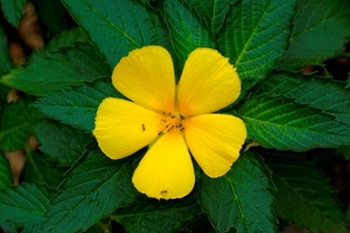
MinerAlert

MinerAlert
Turnera diffusa
Passifloraceae (Turneraceae)
Mexican damiana, Mexican holly, Old woman’s broom.
Damiana de California, Damiana de Guerrero, Hierba de la pastora, Pastorcita, Hierba del venado, Oreganillo.

This aromatic shrub is native to Tropical America, from Mexico to South- America and the Caribbean.
Mainly the leaves, although the flowers and fruit are sometimes used.
Damiana leaves and stems are steeped in water to make a tea. Currently, various dietary supplements containing damiana leaves are also available as capsules or liquid extracts. Certain liqueurs purportedly contain damiana as a flavoring (Mabberley, 2008; Seidemann, 2005).
Safety/Precautions:
Before you decide to take any medicinal herb or herbal supplement, be sure to consult with your health care professional first. Avoid self-diagnosis and self-medication: Always be on the safe side!